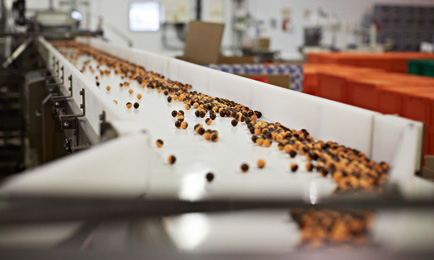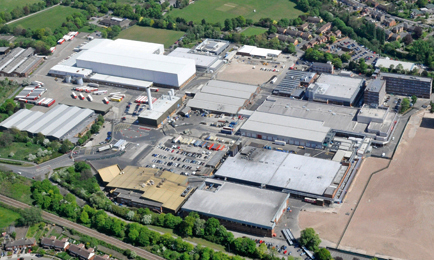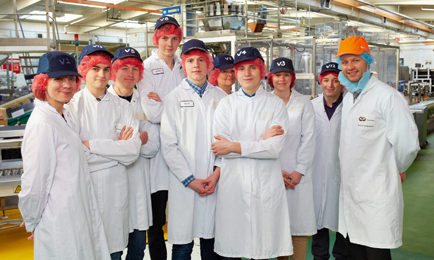Appetising afterthought: Most consumers don’t tend to think how food products are made
What is the UK’s largest manufacturing sector? If you answered aerospace or automotive, guess again. While many may overlook it, food and drink is the single largest manufacturing sector in the country.
Unlike other sectors, it has experienced continued growth throughout the economic downturn.
The 2012 ONS Annual Business Survey shows that the food and drink manufacturing industry generated a turnover of £92 billion, contributing a gross value added (GVA) of £24 billion to the economy and accounting for 18% of the total manufacturing sector by turnover. These statistics translate into a lot of jobs. Today, the sector employs around 400,000 workers – 16% of our overall manufacturing workforce.
The industry is working towards the target of a further 20% growth by 2020. However, to reach this goal, the food and drink manufacturing sector must ensure it can attract new talent, particularly engineers, to drive innovation in an increasingly high-tech, automated environment. This isn’t as easy a task as one would think, with graduates being easily lured into alternative careers in ‘sexy’ industries such as automotive, aerospace or oil and gas.
In a bid to counteract this talent drain, the Food and Drink Federation (FDF), a membership organisation that represents and advises UK food and drink manufacturers, has launched the UK’s first MEng food engineering degree. Created in partnership with the National Skills Academy for Food & Drink, big food and drink manufacturers including Nestlé and KP Snacks, and Sheffield Hallam University, the degree blends mechanical and manufacturing engineering with an understanding of food and food science.
The bespoke syllabus has been designed using the expertise of industry professionals to ensure it reflects the skills needed for a career in food engineering.
After two years of planning, the course is finally complete, and this September saw Sheffield Hallam University take on its first MEng food engineering students. They will be taught a diverse range of topics from thermodynamics, lean manufacturing and automation robotics to food composition and safety, as well as business management and finance.
Andy Rawsthorne, course leader in MEng food engineering at the university, says: “The course is basically a mix of everything, because the industry as a whole is massively broad and diverse.
“The technology varies massively too – from automation and robotics in packaging to pumping and heat exchange systems. It was important that the graduates had a real breadth of knowledge, but also to the required depth.”

Hunger for novelty: Constantly changing consumer trends drive innovation
The course will also provide students with mentors and regular lectures from industry professionals, along with an integrated, paid, 54-week placement at various food manufacturers around the country.
This placement system was set up, says Rawsthorne, to give graduates valuable work experience, but also to show them what it’s really like to work in the modern food and drink manufacturing industry. “It’s an exciting place to be – it’s forever innovating,” he says. “Even if the shape of the chocolate bar changes ever so slightly, the equipment will need to change, the packaging machinery changes the way it’s wrapped, and the moulds will change. There’s a massive engineering effort behind this product that customers don’t think about when they see it on the shelf.”
Sadly, the industry has suffered from an image problem in the past, with young engineers being put off by stereotypical images of “hair nets and steaming cauldrons”, he says.
Richard Martin, technical director for Nestlé UK & Ireland, is one of those in the industry who helped to create the syllabus. He hopes the course will serve to dispel these kinds of incorrect perceptions about careers in food engineering. “The biggest thing we can do to get people to understand what it takes to be an engineer in our business is to open our factory doors and let them see what goes on,” he says.
“When the students come in and see a highly mechanised, highly automated factory – on the KitKat [chocolate bar] plant we make two million products a day – their eyes are opened to the fact that this is a large-scale, high-tech engineering environment.”
Martin says that many of his fellow food engineers didn’t consider a career in the profession as graduates, but once people walk into the industry they rarely walk back out. This is certainly true of his own career. Having previously worked at BP, he moved to the chocolate business and has forged a career at Rowntree, later Nestlé, spanning 27 years. He believes that one of the main reasons people choose to stay working in the industry is the high levels of innovation and the opportunities to solve problems in novel ways.
“To be competitive, and deliver value to consumers in a retail environment – which is probably one of the toughest – offers exciting challenges,” says Martin.
One such challenge is to ensure that factories are incredibly efficient, with minuscule amounts of waste. “You must adopt a resource efficiency mindset,” he says. “You’ve really not just got to be thinking about the ingredients you’re using, but the water, the energy, the labour – all these sorts of considerations.”
Rawsthorne says that the need to reduce waste and energy consumption has led to the creation of new kinds of manufacturing systems. For example, one of Sheffield Hallam’s past projects reclaimed heat from the exhaust of ovens that could then be used to heat water used in other parts of the food manufacturing process.
By using pinch analysis, a methodology for minimising the energy consumption of chemical processes, Nestlé food engineers have been able to look at the combined heating and cooling through its food processes and reclaim wasted heat energy.

Big business: Nestle's confectionery plant illustrates the scale of the industry
These kind of techniques have been used when designing the company’s new £200 million freeze-dried coffee factory, which will make its Nescafé Gold Blend. Martin says: “It’s a product that has existed before, but we have been able to reinvent all the processes, and focus on resource efficiency.”
The factory will use 60% less energy and 60% less water than the previous one, but the product remains unchanged. “It’s the same product – at the end of the day the consumer won’t notice any difference – but we’re looking at it in a different way and putting new technology in place,” he says.
Martin believes that these kinds of inventiveness and creativity are vital to delivering value to the consumer and remaining competitive in the market.
Much of the innovation in the food and drink industry is driven by ever-changing consumer trends. New products must appeal to the public’s diverse tastes, appetites and attitudes.
“For example, one of the biggest innovations in the coffee sector at the moment is the addition of roast and ground coffee within instant coffee,” says Martin. This trend has been driven to satisfy the consumer’s desire for products that taste like the freshly brewed beverages they buy in high-street coffee shops. While Martin says the way in which the coffee is created uses cutting-edge technology, the competitive nature of the industry prevents him from going into any finer details.
Public concerns over health have also had an impact on the food and drink industry, driving not only the invention of healthier snacks, but also the redevelopment of existing ones. Several people in the market have been employing innovative techniques to reduce sugar content or add more fibre into their products. One example, says Martin, was to use aeration to reduce calorie content.
With consumers always on the lookout for something different, it’s no wonder that around 8,000 new products are released into the UK food and drink market every year. Martin says that the dynamic nature of the business is a huge part of its appeal: “It’s not like a new aircraft where you might work on it, and years, or even decades later, you might see it in the air. I tell my undergraduate engineers: the thing that you are going to work on this project will be on the shelf before you finish your graduate placement.”
While the industry clearly offers engineering graduates a host of highly technical challenges to
solve, one of the most challenging and interesting areas is working with the natural food and drink ingredients themselves.
“We’re not machining standard blocks of metals – the ingredients change in the way that you process them and these change from season to season. Getting people to understand how you control this process with an ingredient that has a natural variation and season-to-season variation is incredibly important,” says Martin.
The food products must deliver consistency in taste, texture and smell, so attention to detail is key. Even the slightest variation in the manufacturing process may cause loss of these sensory values. For example, if you need to heat chocolate to cover a KitKat wafer, says Martin, you might use a process that will ensure it reaches the desired value quickly. However, it might well denature the protein of the product.
“You must work out a way to melt the chocolate that will keep it in the best nutritional state with the best possible texture – rather than simply melting it down in an instant and getting it on the biscuit as quickly as possible.”
To ensure that Sheffield Hallam’s food engineering graduates all gain a proper understanding in this area, they’ll be working closely with staff from the university’s food science department, which will also teach them a variety of all-important lessons in food safety.
As the first MEng food engineering students embark on their inaugural year of study, it’s too soon to tell whether the carefully crafted degree programme will be a success. However, it’s certainly the first important step in filling the ever-widening skills gap in the industry. While the course will deliver only around 40-50 graduates a year, Martin hopes that it will create a groundswell effect and produce a surge in similar degrees or training programmes being delivered around the country.
Ultimately, though, it’s about raising the profile of the industry among the host of talented engineers and undergraduates in the UK. Martin says: “I can only share
my experience, and that of my colleagues who have worked in the sector for a long time, with them and let them know what a varied and rewarding career this can be.”
Students gain access to latest techniques used in industry

Sheffield Hallam students on the new MEng food engineering course will also be able to take advantage of a Centre of Excellence to be built at the university.
The £6.9 million centre, funded by the Higher Education Funding Council for England, will host the latest technologies and give students a taste of cutting-edge techniques used in the food and drink manufacturing industry. It will be built to a food-grade level, so students can manufacture products that can actually be consumed.
Andy Rawsthorne, course leader in MEng food engineering at the university, says: “We hope that the centre will foster innovation and become a hub for research and development, where the industry and university can come together and look at some of the major challenges facing the industry.
“The MEng students will help to devise solutions to some of the most pressing problems that they are facing in a diverse range of areas, including waste and energy consumption.”